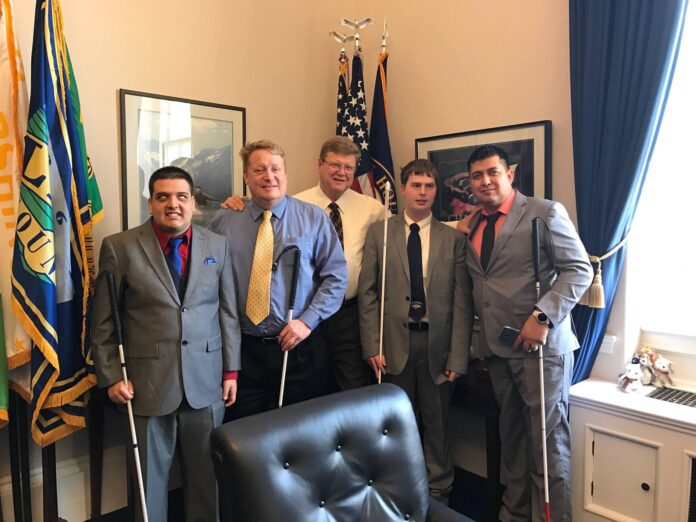Jason Amillio, a UNLV junior, is setting an example for other students on how to speak up for university accessibility. Amillio has a rare form of blindness called Septo Optic Dysplasia, but he does not let that stop him from having a normal college experience.
“No matter where I’ve gone to school, no matter how many times I’ve had the same professor or the same teacher in high school, a lot of times accommodations aren’t met,” Amillio, a UNLV communication student, said.
“Not everything is accommodated for and by that I mean there might be a class where the professor says where we’ll just look at pictures and you’re going to tell me this about them or they might have readings that might not be available to me because they didn’t get to me on time.”
The Disability Resource Center (DRC) provides tools for students with disabilities. The DRC offers a place on campus where students with registered disabilities can receive assistance with their classes, classwork, or anything else relating to their college experience.
Students can go to the DRC to ask how to learn new technology, transcribe books to audio format or braille, or get visual help for classes. The DRC assigns caseworkers to students who works with them throughout their college experience. Although the caseworker will not physically go with a student to every class, they are available to the student in person, online, and over the phone.
“In high school, for people with disabilities, they give you a person to help you throughout the day and work with you,” said Amillio. “Whereas in college, you’re by yourself and kind of have to advocate for yourself by yourself.”
Even though the DRC is available, Amillio has to advocate for himself and reach out to his teachers to make the classroom accessible. The teachers then have to meet with the students and their caseworker to talk about how to correctly adapt the class for that semester. There are different sets of accommodations for each classroom.
In classes that have a science lab or a journalism class that relies on visuals, the DRC will assign someone to go with that student. A few design changes that one instructor made for Amillio as their student includes pictures that need alternative text, readings with available audio, and presentations having a simple design.
“These accommodations were not that hard, I really did not have to go out of my way and once I made it a part of my practice, I actually left that experience realizing I needed to work on every single classroom,” said Doris Morgan Rueda, a UNLV history instructor.
“I should make sure they are all accessible even before a student comes and tells me they need it in an accessible format. Once a classroom is accessible, whatever that means for each individual student, they have the space to engage in the materials.”
One struggle for Amillio is to get an in-person class accessible, so tying in the mandatory online classroom format was difficult. Since Amillio stayed at home during the pandemic, he had to learn how to connect the different apps and access websites with virtually no help.
He needed to learn how to listen to a video of an instructor’s PowerPoint without seeing the powerpoint. If the PowerPoint included videos or links, it made it even more difficult for Amillio to navigate. Third-party apps like Zoom or Webex have a difficult time connecting to Amillio’s audio software.
Amillio fights for accommodations inside of the classroom, but he also needs to speak up for accessible resources on campus, including the Lied Library. The Lied Library features study rooms, computers, and a technology corner for students with visual disabilities. The technology corner includes two tables and a computer with software that can enlarge text, change lighting, and text-to-read.
The text-to-read software is an essential need for Amillio in order to navigate his coursework, but only a few computers in the library include this technology. Amillio said he has personal difficulties with the limited space. The UNLV library staff does not know how to teach him how to use the technology, which makes the overall process more frustrating. This difficult set of circumstances forces Amillio not to utilize the space because of the inaccessibility.
Besides the difficult navigation of the technology corner, there are other problems when it comes to accessibility on campus. Other on-campus resources include bank ATMs, DMV machines, and vending machines.
The one ATM on campus Amillio can use on campus includes the Bank of America ATM. The ATM features tactile markers, braille, and a headphone jack so Amillio can rely on text-to-speech technology.
Outside the library, located in the Student Union is the Rebel Cash ATM, which Amillio cannot use. Unlike the Bank of America ATM, the Rebel Cash ATM lacks braille markers and a headphone jack, so every time Amillio wants to use the machine he needs to ask for outside help.
Amillio hopes that UNLV and other places on campus would take accountability for their accommodations, or lack thereof. And that the next students do not have to go through the battles he is fighting.
“I wish they would accommodate more and not play the, ‘well it’s their job, no it’s his job, no it’s their job game,’” Amillio said. “It’s a dream, but I wish it was more accommodated, where I wouldn’t have to sit here and tell you a bunch of examples.”

